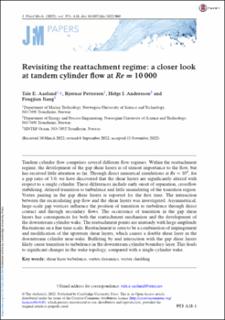| dc.contributor.author | Aasland, Tale Egeberg | |
| dc.contributor.author | Pettersen, Bjørnar | |
| dc.contributor.author | Andersson, Helge Ingolf | |
| dc.contributor.author | Jiang, Fengjian | |
| dc.date.accessioned | 2023-01-12T12:25:08Z | |
| dc.date.available | 2023-01-12T12:25:08Z | |
| dc.date.created | 2022-12-08T08:32:20Z | |
| dc.date.issued | 2022 | |
| dc.identifier.citation | Journal of Fluid Mechanics. 2022, 953 1-31. | en_US |
| dc.identifier.issn | 0022-1120 | |
| dc.identifier.uri | https://hdl.handle.net/11250/3043034 | |
| dc.description.abstract | Tandem cylinder flow comprises several different flow regimes. Within the reattachment regime, the development of the gap shear layers is of utmost importance to the flow, but has received little attention so far. Through direct numerical simulations at Re = 104, for a gap ratio of 3.0, we have discovered that the shear layers are significantly altered with respect to a single cylinder. These differences include early onset of separation, crossflow stabilising, delayed transition to turbulence and little meandering of the transition region. Vortex pairing in the gap shear layers is reported for the first time. The interaction between the recirculating gap flow and the shear layers was investigated. Asymmetrical, large-scale gap vortices influence the position of transition to turbulence through direct contact and through secondary flows. The occurrence of transition in the gap shear layers has consequences for both the reattachment mechanism and the development of the downstream cylinder wake. The reattachment points are unsteady with large amplitude fluctuations on a fine time scale. Reattachment is seen to be a combination of impingement and modification of the upstream shear layers, which causes a double shear layer in the downstream cylinder near-wake. Buffeting by and interaction with the gap shear layers likely cause transition to turbulence in the downstream cylinder boundary layer. This leads to significant changes in the wake topology, compared with a single-cylinder wake. | en_US |
| dc.language.iso | eng | en_US |
| dc.publisher | Cambridge University Press | en_US |
| dc.rights | Navngivelse 4.0 Internasjonal | * |
| dc.rights.uri | http://creativecommons.org/licenses/by/4.0/deed.no | * |
| dc.subject | vortex shedding | en_US |
| dc.subject | vortex dynamics | en_US |
| dc.subject | shear layer turbulence | en_US |
| dc.title | Revisiting the reattachment regime: a closer look at tandem cylinder flow at Re=10000 | en_US |
| dc.title.alternative | Revisiting the reattachment regime: a closer look at tandem cylinder flow at Re=10000 | en_US |
| dc.type | Peer reviewed | en_US |
| dc.type | Journal article | en_US |
| dc.description.version | publishedVersion | en_US |
| dc.rights.holder | © The Author(s), 2022. Published by Cambridge University Press. This is an Open Access article, distributed under the terms of the Creative Commons Attribution licence (http://creativecommons.org/ licenses/by/4.0/), which permits unrestricted re-use, distribution and reproduction, provided the original article is properly cited. | en_US |
| dc.source.pagenumber | 1-31 | en_US |
| dc.source.volume | 953 | en_US |
| dc.source.journal | Journal of Fluid Mechanics | en_US |
| dc.identifier.doi | 10.1017/jfm.2022.960 | |
| dc.identifier.cristin | 2090424 | |
| cristin.ispublished | true | |
| cristin.fulltext | original | |
| cristin.qualitycode | 2 | |

